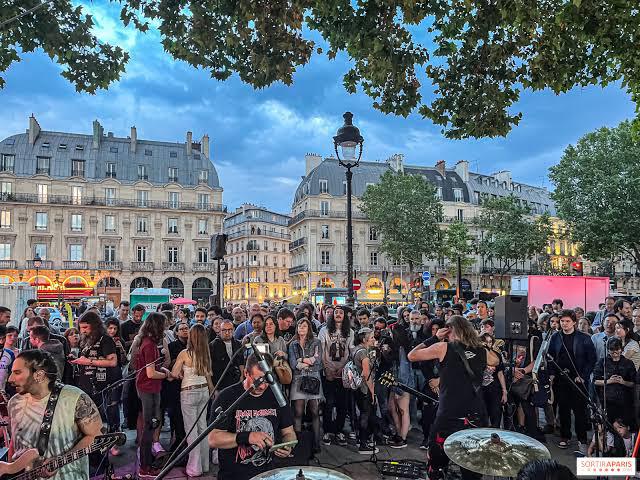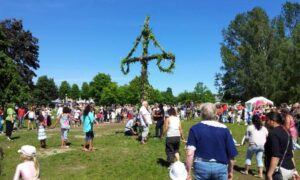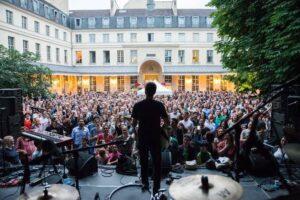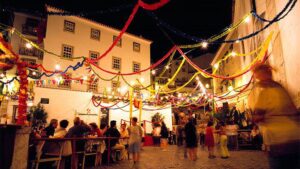In June, while Brazil immerses itself in the vibrant atmosphere of the Festas Juninas — with bonfires, colorful flags, traditional square dancing, and delicious treats like quentão and pamonha — many other nations around the world also celebrate equally rich and deeply meaningful traditions. Each culture, with its unique rituals, turns this month into a time of joy, connection, and reverence for historical and communal roots.
In Sweden, Midsommar, celebrated between June 19 and 25, is one of the most eagerly awaited festivities of the year. Marking the summer solstice, the occasion honors light, fertility, and the abundance of nature. Towns and villages burst into color with traditional flower crowns worn by both children and adults, while groups dance in circles around the maypole — a tall wooden pole decorated with greenery and flowers. Tables are filled with typical dishes like pickled herring, new potatoes with dill, and strawberries with cream, symbolizing gratitude for the earth’s bounty. Midsommar is not just a party; it’s an immersion in ancestral rituals that strengthen family bonds and harmony with the environment.
In France, June 21 turns into a massive artistic celebration: the Fête de la Musique. Coinciding with the summer solstice, on this day the streets, squares, and even narrow alleys become open stages for both professional and amateur musicians. There are no genre restrictions — from classical to jazz, rock to electronic music, all forms of musical expression are welcome. The goal is clear: to democratize music and bring it to every corner, free of charge. In Paris, Lyon, Marseille, and hundreds of other cities, people gather to enjoy spontaneous performances, creating an atmosphere of unity and collective celebration. The Fête de la Musique is, above all, a testament to the transformative power of art.
In Portugal, June is dedicated to the Santos Populares — Popular Saints — with festivities taking over the country from north to south. In Lisbon, the streets of the Alfama neighborhood and other historic centers are lit up and decorated in honor of Saint Anthony, the city’s patron saint. Lovers take part in the Saint Anthony weddings, a tradition dating back to the 18th century. In Porto, the highlight is São João, with bonfires, plastic hammers (used playfully to tap people’s heads), and the famous alhos-porros (wild garlic stalks). The festivities of São Pedro at the end of the month close the season with parades, music, and grilled sardines served with bread and wine. The resemblance to Brazil’s Festas Juninas is no coincidence: both stem from ancient pagan solstice celebrations later adapted by Christianity.
These global celebrations, although distinct in their expressions, share fundamental elements: the appreciation of local traditions, the strengthening of community bonds, and the collective joy. Whether dancing around a maypole in Sweden, strumming a guitar in a French square, or jumping over bonfires in Portugal, the spirit remains the same — celebrating life, culture, and human connection.
Thus, the month of June reveals itself as a magical time across different latitudes, where each nation, in its own unique way, shows that at heart, we all seek the same thing — moments of shared happiness, rooted in our histories and identities.
Português
Em junho, enquanto o Brasil se envolve no clima vibrante das festas juninas, com suas fogueiras, bandeirinhas coloridas, quadrilhas e delícias típicas como o quentão e a pamonha, diversas nações ao redor do mundo também celebram tradições igualmente ricas e profundamente significativas. Cada cultura, com seus rituais únicos, transforma esse mês em uma época de alegria, conexão e reverência às suas raízes históricas e comunitárias.
Na Suécia, o Midsommar, celebrado entre os dias 19 e 25 de junho, é uma das festividades mais aguardadas do ano. Marcando o solstício de verão, a data celebra a luz, a fertilidade e a abundância da natureza. As cidades e aldeias enchem-se de cor com as tradicionais coroas de flores, usadas por crianças e adultos, enquanto grupos dançam em círculos ao redor do maypole (mastro decorado com folhagens e flores). As mesas são repletas de pratos típicos, como arenque marinado, batatas novas com endro e morangos com creme, simbolizando a gratidão pelos frutos da terra. O Midsommar não é apenas uma festa, mas uma imersão em rituais ancestrais que reforçam os laços familiares e a harmonia com o meio ambiente.
Já na França, o dia 21 de junho se transforma em uma grande celebração artística: a Fête de la Musique. Nessa data, que também coincide com o solstício de verão, as ruas, praças e até pequenos becos tornam-se palcos abertos para músicos profissionais e amadores. Não há restrições de gênero — do clássico ao jazz, do rock à música eletrônica, todas as formas de expressão sonora são bem-vindas. O objetivo é claro: democratizar a música, levando-a a todos os cantos, gratuitamente. Em Paris, Lyon, Marselha e em centenas de outras cidades, a população se reúne para curtir apresentações espontâneas, criando uma atmosfera de união e celebração coletiva. A Fête de la Musique é, acima de tudo, um testemunho do poder transformador da arte.
Em Portugal, junho é dedicado aos Santos Populares, com festas que tomam conta do país de norte a sul. Em Lisboa, as ruas do bairro de Alfama e outros centros históricos enchem-se de luz, balões e decorações coloridas em homenagem a Santo Antônio, padroeiro da cidade. Os casais apaixonados participam dos casamentos de Santo Antônio, uma tradição que remonta ao século XVIII. No Porto, o São João é a grande atração, com suas fogueiras, martelinhos de plástico (que os foliões batem uns na cabeça dos outros, num gesto de brincadeira) e os famosos alhos-porros. Já as festas de São Pedro, no final do mês, encerram as comemorações com desfiles, música e sardinhas assadas, acompanhadas de pão e vinho. A semelhança com as festas juninas brasileiras não é mera coincidência: ambas têm origem nas celebrações pagãs do solstício, adaptadas pelo cristianismo.
Essas celebrações globais, embora distintas em suas manifestações, compartilham elementos fundamentais: a valorização das tradições locais, o fortalecimento dos laços comunitários e a alegria coletiva. Seja dançando ao redor de um maypole na Suécia, tocando violão numa praça francesa ou pulando fogueiras em Portugal, o espírito é o mesmo: celebrar a vida, a cultura e a conexão entre as pessoas.
Assim, o mês de junho se revela como um período mágico em diferentes latitudes, onde cada nação, com sua singularidade, demonstra que, no fundo, todos buscamos o mesmo — momentos de felicidade compartilhada, enraizados em nossas histórias e identidades.











